RETRACTED: Impacts of enhanced recovery after surgery nursing interventions on wound infection and complications following bladder cancer surgery: A meta-analysis
Abstract
A meta-analysis was executed to comprehensively examine the impacts of enhanced recovery after surgery (ERAS) care interventions on complications and wound infections following bladder cancer (BCa) surgery. Computer searches were carried out in Embase, Google Scholar, Cochrane Library, PubMed, Wanfang and CNKI, from their inception to November 2023, for RCTs regarding perioperative ERAS nursing interventions in patients with BCa. Two independent researchers performed literature screening, extracted data and carried out quality evaluations. Stata 17.0 software was utilized for the analysis of the data. Ultimately, 16 RCTs, involving 1190 patients, were included. The analysis showed that, in comparison with conventional nursing methods, perioperative ERAS nursing application in patients with BCa remarkably decreased the occurrence of wound infections (OR: 0.31, 95% CI: 0.16–0.59) and complications (OR: 0.19, 95% CI: 0.13–0.28). Our study indicates that perioperative care based on the ERAS concept remarkably decreased the occurrence of wound infections and complications following BCa surgery, demonstrating notable nursing efficacy and meriting widespread clinical promotion.
1 INTRODUCTION
Bladder cancer (BCa) is a malignant tumour originating from the urothelium of the bladder and is one of the most common malignancies of the urinary system.1-3 Global cancer statistics from 2020 show that BCa ranks ninth in incidence and thirteenth in mortality among all cancers.4 With the widespread use and development of laparoscopic technology in urology, laparoscopic radical cystectomy has become the main treatment for BCa.5, 6 However, this procedure is one of the most complex in urology and is associated with many complications. Factors such as the disease itself, anaesthesia and surgical trauma can induce negative emotions like depression and anxiety, as well as pain and discomfort in patients, exacerbating the body's stress response and hindering postoperative recovery.7-9 Therefore, implementing scientific perioperative nursing measures to promote patient recovery and reduce postoperative complications is of significant importance.
Traditional perioperative management has limited effectiveness in facilitating rapid postoperative recovery and no longer meets the needs of clinicians and patients. The concept of enhanced recovery after surgery (ERAS) focuses on reducing patient trauma-related stress and enhances both physiological and psychological recuperation, thereby considerably reducing the overall recovery duration.10, 11 In recent years, ERAS has been implemented across various surgical disciplines, yielding favourable clinical outcomes.12-14 Therefore, this paper aims to collect randomized controlled trials (RCTs) regarding perioperative intervention of the ERAS program following BCa surgery, to examine the impacts of ERAS application on postoperative complications and wound infection following BCa surgery.
2 MATERIALS AND METHODS
2.1 Literature search
Keywords such as enhanced recovery after surgery, bladder cancer, BCa, enhanced recovery after surgery care, ERAS and fast-track surgery were used in a combined manner of subject—and free—words to search RCTs on perioperative ERAS nursing interventions for patients undergoing BCa surgery, from database inception to November 2023, in Embase, Cochrane Library, China National Knowledge Infrastructure, Google Scholar, PubMed and Wanfang databases.
2.2 Eligibility criteria
2.2.1 Inclusion criteria
(1) Participants: diagnosis of BCa was confirmed by pathological examination; (2) outcomes: complications and wound infections; (3) design: only RCTs; (4) intervention: for the experimental group, perioperative ERAS nursing intervention was applied, while the control group received conventional nursing.
2.2.2 Exclusion criteria
Repeatedly published articles; literature missing complete original data or full text; reviews, conference papers, animal studies and systematic reviews.
2.3 Data extraction and quality assessment
Data extraction, including publication year, first author, gender, age and sample size, was carried out using Excel software. The Cochrane collaboration recommended tool was utilized to determine RCTs, focusing on selection, implementation, measurement, follow-up, reporting and other biases.
2.4 Statistical analysis
Stata 17.0 (StataCorp, Texas, TX, USA) was the software applied in this analysis. Odds ratios (OR) with its 95% confidence intervals (CIs) was utilized to compare dichotomous variables. Heterogeneity was determined by the χ2 test and I2 values. The random-effects model was utilized for significant heterogeneity, while the fixed-effect model was utilized for studies lacking heterogeneity. Sensitivity analysis was executed to examine the robustness of our findings. Publication bias was visualized through funnel plots when the number of included studies exceeded 10.
3 RESULTS
3.1 Basic characteristics
The literature screening process is shown in Figure 1. A total of 398 articles were initially identified, 196 duplicates were removed manually and using software, 132 articles not meeting the study criteria were excluded after reading titles and abstracts, and after full-text reading of the remaining 70 articles, 16 RCTs15-30 were finally included, involving 1190 BCa patients, with 595 in both the ERAS and conventional nursing groups. The basic characteristics of the included literature are shown in Table 1. Literature quality assessment is shown in Figure 2.
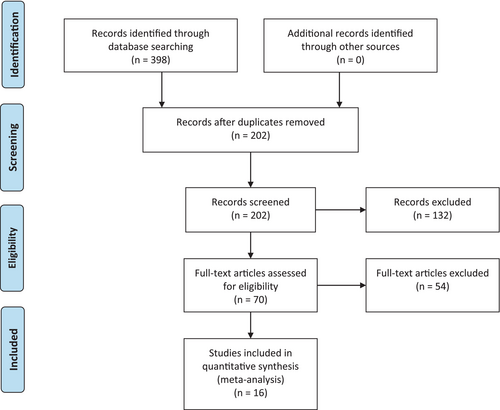
| Author | Year | No. of patients | Age (years) | Sex (male/female) | |||
|---|---|---|---|---|---|---|---|
| Intervention | Control | Intervention | Control | Intervention | Control | ||
| Sun | 2019 | 32 | 32 | 61.5 ± 9.8 | 59.2 ± 10.1 | 25/7 | 24/8 |
| Qu | 2023 | 40 | 40 | 50.31 ± 6.82 | 50.28 ± 6.74 | 29/11 | 28/12 |
| Qiu | 2021 | 38 | 38 | 52.03 ± 7.61 | 51.17 ± 7.33 | 24/14 | 21/17 |
| Luo | 2023 | 35 | 35 | 68.36 ± 2.24 | 68.32 ± 2.25 | 32/3 | 33/2 |
| Liu | 2020 | 46 | 46 | 53.24 ± 15.67 | 52.67 ± 14.72 | 32/14 | 31/15 |
| Tu | 2021 | 37 | 37 | 59.34 ± 4.65 | 59.22 ± 4.37 | 19/18 | 20/27 |
| Chang | 2019 | 35 | 35 | 59.82 ± 5.61 | 59.02 ± 6.93 | 29/6 | 31/4 |
| Zheng | 2021 | 35 | 35 | 56.49 ± 4.19 | 56.51 ± 4.23 | 28/7 | 25/10 |
| Zhu | 2019 | 29 | 29 | 53.60 | 53.49 | 18/11 | 17/12 |
| Zhao | 2020 | 35 | 35 | 59.5 ± 4.9 | 60.9 ± 5.5 | 25/10 | 28/7 |
| Zhao | 2023 | 37 | 37 | 54.35 ± 2.07 | 54.29 ± 2.14 | 19/18 | 21/16 |
| Zhang | 2019 | 50 | 50 | 65.01 ± 1.72 | 67.01 ± 1.21 | 35/15 | 34/16 |
| Yin | 2021 | 30 | 30 | 46.32 ± 16.58 | 47.22 ± 17.39 | 18/12 | 19/11 |
| Yi | 2021 | 32 | 32 | 61.56 ± 3.64 | 61.02 ± 3.09 | 28/4 | 27/5 |
| Wu | 2021 | 44 | 44 | 67.52 ± 4.86 | 67.59 ± 5.02 | 40/4 | 39/5 |
| Wang | 2021 | 40 | 40 | 59.41 ± 8.94 | 59.66 ± 8.82 | 33/7 | 31/9 |
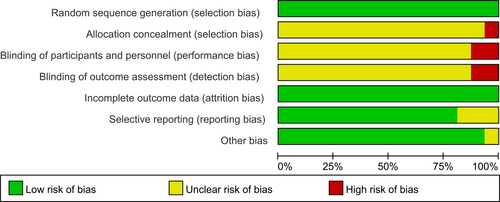
3.2 Wound infection
Sixteen RCTs compared wound infections. Thirteen out of 595 patients had infections in the ERAS group, while 39 out of 595 patients had infections in conventional nursing group. No significant heterogeneity (I2 = 0.0%, P = 1.000) was noted, and fixed-effect model was employed. It was found that, in comparison with the conventional nursing methods, the occurrence of wound infections was remarkably lower (OR: 0.31, 95% CI: 0.16–0.59, p < 0.001) in the ERAS group (Figure 3).
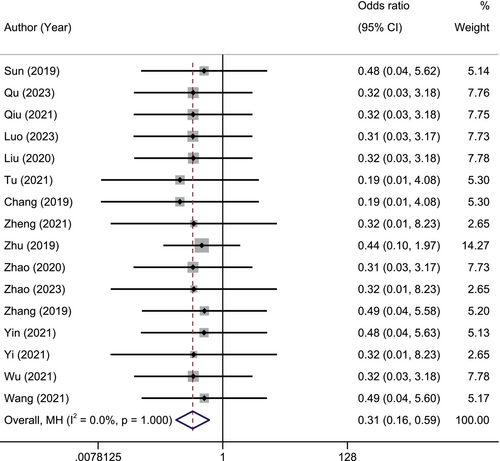
3.3 Complications
Sixteen RCTs compared complications. In the ERAS group, 40 out of 595 patients had complications; in the conventional nursing group, 153 out of 595 patients had complications. No substantial heterogeneity (I2 = 0.0%, p = 1.000) was noted, and fixed-effect model was employed. It was found that, in comparison with the conventional nursing methods, the occurrence of complications was remarkably lower (OR: 0.19, 95% CI: 0.13–0.28, p < 0.001) in the ERAS group (Figure 4).
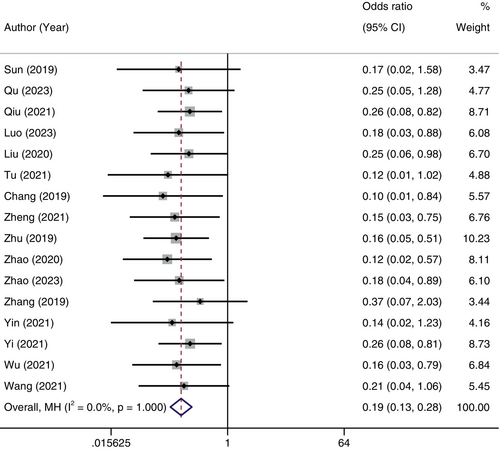
3.4 Sensitivity analyses and publication bias
Sensitivity analyses suggested that our findings were reliable (Figure 5). The funnel plot, depicted in Figure 6, was mostly symmetrical, indicating a low probability of publication bias.
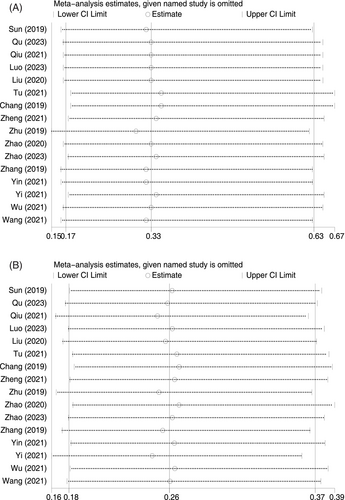
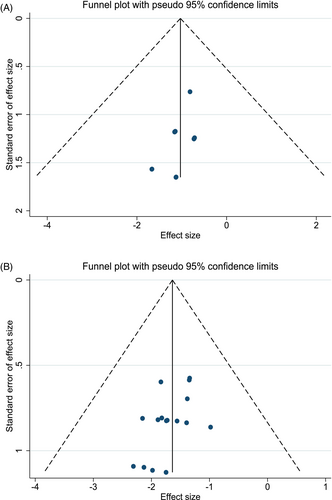
4 DISCUSSION
Since the application of the ERAS concept in clinical practice, perioperative care based on the ERAS concept has been widely applied in surgical fields such as gynaecology,31 gastrointestinal surgery,32 hepatobiliary surgery33 and cardiothoracic surgery,34 but its application in urology has been relatively less reported. In recent years, the application of the ERAS concept in urology has gained increasing clinical attention.35, 36 Guan et al.37 found in a retrospective analysis that ERAS significantly shortened the postoperative hospital stay of BCa patients, reduced hospital costs and decreased readmission rates and postoperative complication rates. Saar et al.38 also showed that the use of the ERAS program promoted patient recovery. Published data indicate that implementing the ERAS approach for BCa is safe and feasible in the perioperative period, accelerating patient recovery.
Surgical treatment is invasive and inevitably increases the risk of opportunistic pathogen invasion, thereby increasing the probability of postoperative wound infection in patients.39 Postoperative wound infections in BCa patients not only affect surgical outcomes but also severely impact patient prognosis and can even lead to death.40, 41 Our results showed that, in comparison with the conventional nursing methods, the occurrence of wound infection was remarkably decreased in the ERAS group. Rich et al.42 also found that after ERAS nursing intervention, the occurrence of wound infection within 30 days postoperatively decreased from 8.7% to 1.2%. This suggests that perioperative management guided by the ERAS concept can reduce the occurrence of wound infection following BCa surgery, promoting patient recovery and representing a suitable perioperative management model for BCa patients. The reasons are as follows: malnutrition can prolong wound healing time and increase the probability of wound infection, delaying patient recovery. Nutritional support, as an important part of the ERAS concept, involves comprehensive nutritional assessment before surgery to provide more scientific and rational nursing services to patients, coupled with enhanced postoperative wound care to promote wound healing, thus preventing wound infection.43, 44
Due to the impact of bodily stress and surgical operations, there is a heightened risk of postoperative complications, including urinary incontinence and anastomotic fistula, which adversely affect prognosis and impede swift recovery after surgery.45 Our results showed that, in comparison with the conventional nursing methods, the occurrence of complications were remarkably lower in the ERAS group. Similar to the findings of Tyson et al.,46 which further suggests that the application of ERAS measures for BCa surgical patients is safe and feasible and worthy of widespread application in the perioperative period. The reasons are as follows: First, better nutritional support helps patients recover gastrointestinal function and improve nutritional status, reducing the incidence of gastrointestinal complications.47 Second, through scientific and reasonable physical exercise, patients can fully move their limbs, accelerate blood circulation in the body, prevent postoperative complications and facilitate early recovery from illness.48
However, certain limitations should be acknowledged: First, the included literature is only in Chinese, lacking high-quality articles published in other languages, affecting the comprehensiveness of the data; second, the selected samples are mostly from the Asian patient population, so the research data may have regional differences; third, the sample size of the included studies is small, and more research is needed for further verification.
5 CONCLUSIONS
In conclusion, the application of the ERAS concept in the perioperative management of patients with BCa can reduce the incidence of wound infections and complications, promoting postoperative recovery. It is worth promoting and applying in clinical practice.
CONFLICT OF INTEREST STATEMENT
The authors declare that there is no conflict of interest.
Open Research
DATA AVAILABILITY STATEMENT
The data that support the findings of this study are available from the corresponding author upon reasonable request.




